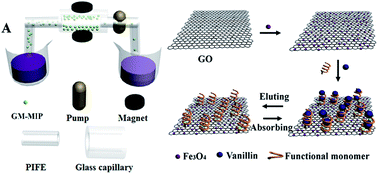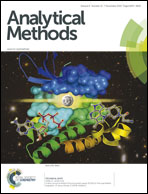A novel chemiluminescence sensor for determination of vanillin with magnetite–graphene oxide molecularly imprinted polymers
Abstract
A novel chemiluminescence (CL) sensor for the on-site determination of vanillin using the system of luminol–KMnO4–NaOH based on a magnetic graphene oxide molecularly imprinted polymer (GM-MIP) is described. The vanillin–GM-MIP system, which has the merits of easy separation, high selectivity and a large amount of adsorption, was synthesized as a vanillin recognition material in the CL analysis, where the GM-MIP column was placed ahead of the pump in the experimental setup so as to increase the selectivity of CL analysis. The GM-MIP was characterized by SEM, XRD, TEM and FTIR, and also for its adsorption ability, selectivity and reusability. The GM-MIP-CL sensor responded linearly to the concentration of vanillin over the range 3.3 × 10−7 to 1.2 × 10−5 mol L−1 with a detection limit of 1.1 × 10−7 mol L−1 (3δ). The RSD was 3.9%, and on the basis of speediness and high selectivity the sensor showed a great improvement in selectivity and adsorption capacity. Finally, the sensor was applied to the determination of vanillin in practical samples, and the recoveries were between 6% and 8%. The sensor was an easily producible, simple automatic column packing with high selectivity.


 Please wait while we load your content...
Please wait while we load your content...